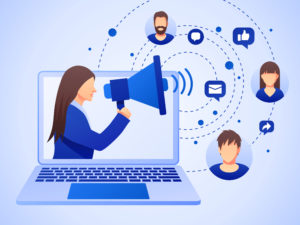
Social Listening: The Sweet Spot of Food and Beverage Online Tracking

Remember the days when consumers registered their product thoughts and comments to the manufacturer by dialing an 800 toll-free number? The process was often a frustrating experience that included long hold times and speaking with company representatives who were always indifferent to the consumers’ feedback. How far we have come!
When companies added social media as a customer response option, they were often unprepared for the onslaught of instantaneous public input from social channels. Because social media amplifies consumers’ thoughts (good or bad) so quickly in a public forum, companies must be ready with strategies that go beyond standard, canned responses. This instant feedback environment is a two-way flow of information between consumers and brands. Tapping into this conversation can yield a wealth of information that focus group sessions could never capture; the dynamics of the consumer-to-keyboard interactions are very different from face-to-face conversations.
However, if companies focus only on monitoring activity on their social media channels alone, they are not unlocking the beneficial insights in other online conversations. Evolving brands’ understanding of themselves (by gathering all relevant data from all available channels—agnostic to platform or channel owner) is a key outcome of Social Listening.
Social Listening collects and derives insights from all publicly available social mentions, no matter where they occur online. It uses sophisticated linguistic modeling to collect relevant posts and comments on social media platforms (e.g., Twitter, Facebook, Instagram, Tumblr, TikTok, etc.), which can then be analyzed. As a result, social listening provides an invaluable resource that informs brand teams about consumer behaviors, preferences, and intent.
By contrast, Social Monitoring is the practice of companies exclusively looking at their social profiles on Twitter, Facebook, Instagram, etc. This lack of vision can cause brands to miss the bigger picture by severely limiting their scope. Often the most valuable insights occur outside their owned channels and live on other social media platforms.
Social Change, Social Potential
Trend analysis, competitor comparisons, and crisis management are all standard Social Listening elements that can be further broken down to specific platform behaviors, discussion topics, user types, and product/brand classification. Appreciating these components and how they interact will allow brand teams to deeply understand benchmarks, trends and other events, which include but are not limited to activist campaigns, packaging complaints, and concerns from or about employees.
Consider the example of a well-known and much-loved snack food company in the middle of a nationwide product recall. The brand needed up-to-the-minute data regarding the online activity of consumers and the nationally syndicated media coverage to inform their PR, corporate communication, and risk mitigation strategies. Social Listening provided frequent alerts with critical information to key organizational stakeholders. As a result, all other marketing activity was halted, and accurate and timely posts about the recall were pushed through all channels. In addition, Social Listening enabled the company to determine the pivot point in recall volume by establishing an average daily threshold based on a historical analysis of previous recall activity. The real-time information gave the company the confidence to resume outgoing marketing messaging without fear of consumer backlash.
Attitude is Everything
Consumer attitude analysis is a hallmark of Social Listening. Attitude analyses work in place of, or in concert with, traditional market research tactics, confirming or confounding assumptions made by other research teams. Typical corporate branding questions used to analyze attitude include:
- “What are the most-desired seasonal flavors across my industry? How early are consumers looking to find these flavors in the market?”
- “How is my brand performing with users who care about ‘clean label’ or ‘green energy’ concerns? How do my competitors perform with these same users?”
- “What are my consumers’ other interests? How can I leverage these to maximize marketing efforts?”
With answers to these questions, experienced Social Listening analysts can determine the motivating factors behind brand loyalty. For example, when a sweet baked goods brand had questions about customer loyalty, they turned to Social Listening. They found that product quality and customers integrating their products into special occasions were primary loyalty drivers. In addition, they discovered an adverse driver regarding product availability and distribution issues; consumers were having trouble accessing their favorite products. The analysis also revealed that negative mentions around all loyalty categories for their competitors increased exponentially year over year for the previous three years. However, positive comments about the sweet baked goods brand had aggressively increased during this time. As a result, the company created a new messaging strategy using the Social Listening analysis to help continue and elevate positive brand momentum, outpacing its competitors.
Piece of Cake
Social Listening compiles reports, identifies trends, and delivers alerts in a company’s preferred cadence and format. Unlike Social Monitoring, Social Listening can access the most relevant, critical consumer comments and dialogues on social platforms—while minimizing noise. With this in-depth knowledge of the key elements of consumer attitudes, organizations can develop new data-driven strategies to deliver products and services while avoiding potentially adverse outcomes like consumer backlash, decreased sales, and the need for crisis communications. 
About the author: Anne Erickson is Analytics Manager, Real Time Intelligence Manager and Senior Consultant at Anexinet. She has been a leader in the field of Social Listening since 2011, with specialties that include Food/Beverage, Consumer Packaged Goods, and Telecom reporting, as well as Real-Time Social Monitoring, Social Risk Alerting, and Crisis Management.
Related Items:
Are You Really Listening To Your Customers? Use Social Data
‘Narrative Analytics’ Targets Consumer Beliefs
Social Cooling: Living in a Big Data Society
































